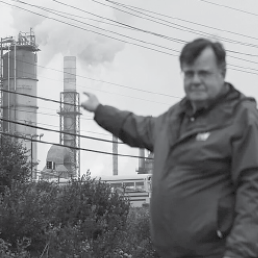How a Citizen Took on the Oil Refinery

When Gordon Dalzell learned that the Irving Oil refinery’s air quality permit was up for review, he got to work. A clean air activist based in Saint John, New Brunswick, Dalzell hunkered down with his research, hoping to hit back at one of Canada’s biggest polluters.
In Champlain Heights, where Dalzell has lived since 1977, there are about 100 homes, an elementary school, and a community college. Trees block the refinery, the country’s largest, from view, but look at a satellite image and next door you see more than two dozen tanks dotting the landscape. In the past decade, multiple published reports have detailed excess discharges of fine particulate matter from the refinery’s smokestacks. In 2018, the facility pumped a black, grainy mystery product from the smokestacks, and although the residents of Champlain Heights received apology letters from Irving, neither the company nor the New Brunswick government revealed what the substance was.
Dalzell isn’t one to stay quiet. He was once kicked off an Irving Oil environmental committee for sharing information with Reuters. And for the last 25 years, he has been a citizen activist in various provincial and federal forums, so providing input on establishing the refinery’s regulations for the next five years wasn’t new. His 200-page, handwritten submission raised 33 issues, ranging from benzene coming from the plant to emission monitoring.
Due in part to Dalzell’s prodding, the limits of both nitrogen oxide and sulphur dioxide emission levels for the refinery were reduced to 4,500 tonnes annually — a decline of 18 and 13 percent respectively. He also convinced the province to lower the acceptable levels of particulate matter in Irving’s emissions. But he wonders if more could have been accomplished.
It’s a question relevant not only in New Brunswick, but in the broader context of participation in environmental policy development across the country. Canadians have had the opportunity to participate in environmental processes for more than 25 years federally, via the Canadian Environmental Assessment Act. Regulation for specific issues, like air quality, falls to provinces, which have their own mechanisms. In fact, Dalzell’s activism helped make this a reality in New Brunswick after demanding public participation in the province’s Clean Air Act in 1997.
Governments have done a great deal of work to create channels for the public to make their voices heard by decisionmakers. But just because opportunities exist doesn’t mean people are ready or willing to speak up. And public participation certainly isn’t a silver bullet for better environmental policies.
In a 1997 paper, environmental lawyer Andrew Green suggested public participation could lead to less than optimal results: risking overregulation when public demand for control is high or underregulation when interest is low. The underlying issue, he said, is the environmental policies themselves. Public participation can’t be seen as a way to counterbalance old regulations that favor the desires of industry.
Across Canada, some provincial air quality standards are long out of date, and public participation can result in stricter guidelines for permits and approvals than what regulations dictate. New Brunswick’s air quality regulation, for instance, has not been comprehensively reviewed since its 1997 inception. In Ontario, it took almost 45 years and the prodding of environmental law organization Ecojustice for the province to lower its sulphur dioxide standards.
Lois Corbett of the Conservation Council of New Brunswick calls the province’s mechanisms to participate one of the country’s worst. “The onus for fairness, openness and transparency lies with the Department of Environment and with government in general,” she says.
For the province to do better, Corbett says, it would need to take a more hands-on role in connecting citizens with the process. But in New Brunswick, where an estimated one person out of every twelve works for Irving, she feels there’s a public cynicism overshadowing the process. “They don’t believe that the government is making decisions on their behalf and it didn’t matter who weighed in, with what evidence. There wouldn’t be a change.”
In other areas most impacted by polluting sites across the country, similarly divided loyalties can be present. In recent cases where public participation was requested on projects with potential environmental impacts, participation varied widely by project and sector. In Sarnia, Ontario, a city, like Saint John, impacted by air pollution due to local Imperial Oil and Shell refineries, a recent air compliance approval had no public participation at all. Yet recent changes to regulations around forestry in Ontario saw 25 submissions and 1,200 emails.
Shaun Fluker, associate professor at the University of Calgary’s law faculty, says big numbers can be misleading. They may indicate participants using form letters or email templates, rather than engaging in a more substantive way. But the question remains why participation happens in a big way in some cases, and is so limited in others.
Clinton Westman, associate professor in archaeology and anthropology at the University of Saskatchewan, who counts among his research interests environmental policy participation, points to the Trans Mountain pipeline as an example of ranges in participation. When it was built in the 1950s, there was no formal opportunity for public participation in approving the pipeline between Edmonton and Burnaby, British Columbia. But when Kinder Morgan proposed building another pipeline, largely along the same route, public interest was high. Westman notes many of the channels for participation, including information sessions and online engagement, have been created due to hard work from activists. “But they seem to also become prone to being co-opted or prone to kind of not fulfilling all the potential for public participation that people thought that they had.”
Hundreds of Canadians were denied the opportunity to present concerns over Trans Mountain after federal legislation led the National Energy Board to include only participants who were “directly affected” or with expertise or relevant information on a given issue. This came after Enbridge’s Northern Gateway pipeline inspired record participation for an NEB review, causing the project’s supporters to bemoan the length of the approval process. In an open letter, then natural resources minister Joe Oliver complained about the volume of participants, alleging environmental groups and “radicals” had “hijacked” the regulatory system. Despite more than 4,000 10-minute oral statements opposing Northern Gateway, the project was still approved, which leads to the question: how do regulators actually weigh the public input they receive on any given project?
Anna Johnston, a lawyer with West Coast Environmental Law, says any weighing act can vary between federal and provincial processes, and that some panels have independent experts who bring their own opinions on the value of public submissions. For example, she’s heard different feedback on the effectiveness of letter-writing campaigns which produce thousands of cookie-cutter responses. “On the one hand, it could be a demonstration of strong public interest in a particular issue of the product, and people are taking the time to click a button, while others think that there’s such a small amount of energy required to click that button that doesn’t really demonstrate much interest at all.”
Johnston says she’s also seen processes where it seemed like the assessment authority was deeply moved by people’s submissions. “And then there are other times where the decisionmaking is such a black box, that the decisionmakers don’t ever show how public comments have been taken into account, if at all,” she adds. “But it appears from the outside that all of that energy — and often money and resources — have been a waste of time.”
Canada’s public participation landscape isn’t full of happy stories like Dalzell’s. Westman mentions material outlining proposed projects or issues up for review can be complicated and dense. Marginalized groups — who often live in disproportionately impacted areas — don’t always get heard, for instance when the reviewer limits the number of Indigenous communities that can claim to be impacted.
There’s no consensus on how to get more people more involved in public participation processes. “I think that the public is really underserved often by the consultation processes that the governments bring forward,” says Kai Nagata, energy and democracy director at the B.C.-based citizen action group Dogwood. “And so grassroots groups or [environmental groups] or municipal governments sometimes can serve a role as an intermediary to basically translate what’s at stake, and encourage people to make their voice heard.”
In Nagata’s view, mobile-friendly online processes, including ditching fax communications for emails and surveys, would encourage engagement. “There are areas where the government is decades behind technology and the way people actually use and share information.” Dogwood has proof this works, having helped thousands of people sign up to present at Enbridge’s Northern Gateway hearings through the creation of an online form which indeed was then sent via a fax to the National Energy Board.
Dalzell thinks people don’t participate for multiple reasons, including a belief someone else will, and a perceived lack of time. He estimates he spent between 60 and 70 hours working on his submission for the Irving air quality permit review. Fluker, the University of Calgary professor, says one of the most common challenges is the cost of experts. “Frankly, there’s not a lot of people that have access to those sorts of experts or have the training to really flesh out some of those weaknesses in a proponent’s case,” he says. Cost assistance exists in some jurisdictions to pay people back after the fact.
For his role, Dalzell’s education and training is in social work. He’s not a trained scientist, but developed the fluency and comfort he has today with esoteric environmental processes over thirty years of working alongside community groups. This includes the Citizens’ Coalition for Clean Air, which gathered 13,000 signatures on a petition while lobbying for New Brunswick’s Clean Air Act.
Dalzell and others have found there is a wide gulf between acknowledging climate change’s impacts and people’s willingness to help counteract it. Given the immensity of global climate concerns, it might seem like small potatoes to work on something in your backyard. But that’s a sentiment with which Corbett disagrees. Speaking of Irving Oil, he says, “I don’t think that there’s anything about the largest refinery on the East Coast that’s ever small.”
Academics have noted that, despite success in creating pathways, like public participation processes, to get information to decisionmakers and experts, these avenues don’t necessarily collect the local knowledge and first-hand experiences of individuals. And Dalzell says there’s a lot of value in individual stories in these processes. One of the catalysts for him to put pen to paper for Irving’s air quality review was the memory of a neighbor who passed away two decades ago from an asthma attack. “When I look back, it was just one of those driving forces that caused me to respect her wish,” he says. “And the other thing is, I knew a lot of people in the neighborhood who kind of depended on me over the years to do this advocacy work.”
Considering the refinery’s entry on the National Pollutant Release Inventory — two-and-a-half printed pages of air toxins and chemicals, including benzene, arsenic, and lead — Dalzell says, “It’s a wonder we all haven’t died of cancer in the neighborhood here.” Indeed, “The citizen is the expert in terms of their own health, their own impact on quality of life.” TEF
PROFILE When it comes to those yawn-worthy, overly technical, bureaucratic reviews of major projects like refineries and pipelines — is public participation really even worth the effort? Citizen Gordon Danzell’s lonely battle against dangerous air pollution says yes.
